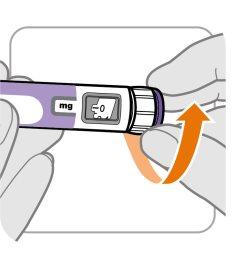
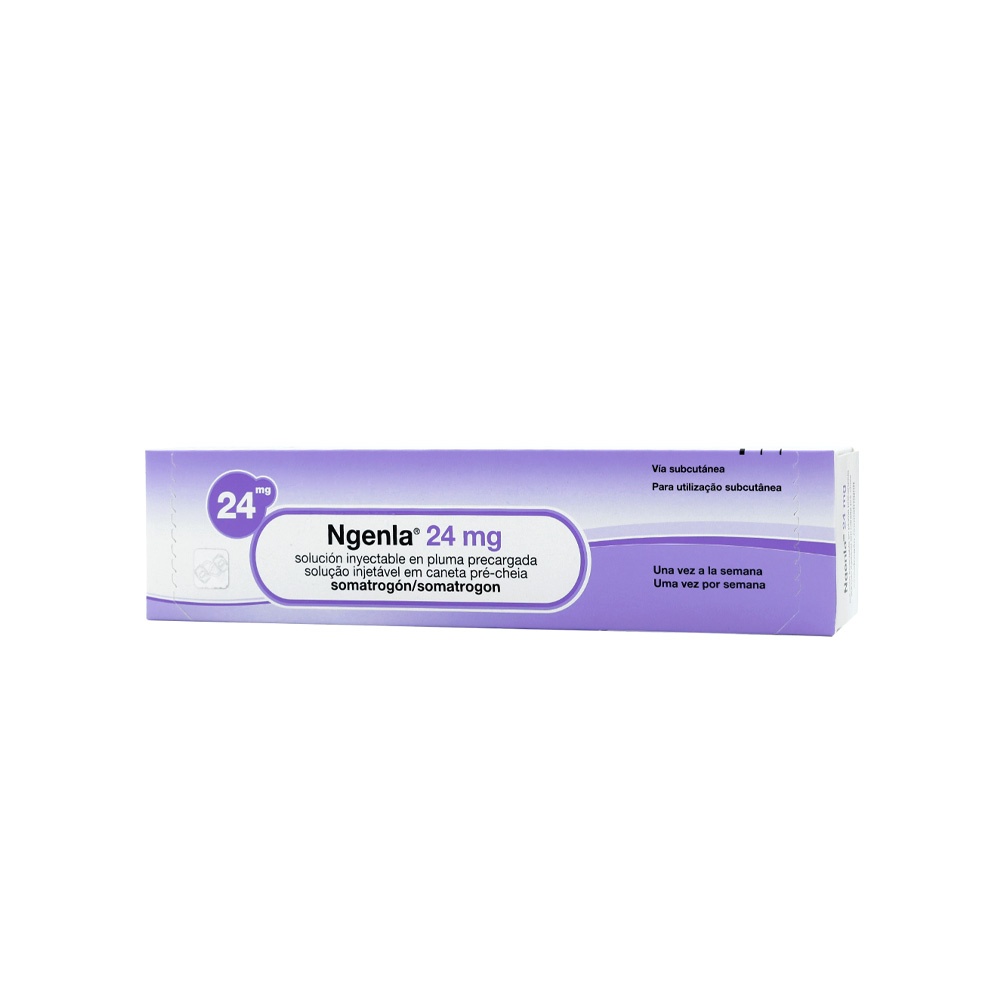
НГЕНЛА 24 мг Раствор для инъекций в предварительно заполненной шприц-ручке

Спросите врача о рецепте на НГЕНЛА 24 мг Раствор для инъекций в предварительно заполненной шприц-ручке

Инструкция по применению НГЕНЛА 24 мг Раствор для инъекций в предварительно заполненной шприц-ручке
Введение
Инструкция: информация для пациента
Нгенла 24мг раствор для инъекций в предварительно заполненном шприце
соматрогон
Этот препарат подлежит дополнительному мониторингу, что позволит оперативно обнаружить новую информацию о его безопасности. Вы можете внести свой вклад, сообщая о побочных эффектах, которые могли бы возникнуть у вас. В конце раздела 4 содержится информация о том, как сообщать о этих побочных эффектах.
Прочитайте внимательно всю инструкцию перед началом использования этого препарата, поскольку она содержит важную информацию для вас.
- Сохраните эту инструкцию, поскольку вам может потребоваться перечитать ее.
- Если у вас есть какие-либо вопросы, проконсультируйтесь с вашим врачом, фармацевтом или медсестрой.
- Этот препарат назначен только вам или ребенку под вашим уходом, и его не следует давать другим людям, даже если они имеют те же симптомы, что и вы или ребенок под вашим уходом, поскольку это может нанести им вред.
- Если вы или ребенок под вашим уходом испытываете побочные эффекты, проконсультируйтесь с вашим врачом, фармацевтом или медсестрой, даже если это побочные эффекты, не указанные в этой инструкции. См. раздел 4.
Содержание инструкции
- Что такое Нгенла и для чего она используется
- Что нужно знать перед началом использования Нгенлы
- Как использовать Нгенлу
- Возможные побочные эффекты
- Хранение Нгенлы
- Содержание упаковки и дополнительная информация
1. Что такое Нгенла и для чего она используется
Нгенла содержит активное вещество соматрогон, модифицированную фармацевтическую форму человеческого гормона роста. Человеческий гормон роста необходим для роста костей и мышц. Он также помогает в развитии жира и мышечных тканей в необходимых количествах. Нгенла используется для лечения детей и подростков от 3 лет, у которых недостаточно гормона роста и которые не растут с нормальной скоростью.
Активное вещество Нгенлы производится с помощью «технологии рекомбинантной ДНК». Это означает, что оно создается в клетках, модифицированных в лаборатории для производства этого вещества.
2. Что нужно знать перед началом использования Нгенлы
Не используйте Нгенлу
- Если вы или ребенок под вашим уходом аллергичны к соматрогону (см. «Предостережения и меры предосторожности») или к любому другому компоненту этого препарата (перечисленному в разделе 6).
- Если вы или ребенок под вашим уходом имеете активную опухоль (рак). Сообщите вашему врачу, если вы или ребенок под вашим уходом имеете или имели активную опухоль. Опухоли должны быть неактивными, и вы или ребенок под вашим уходом должны завершить противоопухолевое лечение перед началом лечения Нгенлой.
- Если вы или ребенок под вашим уходом перестали расти из-за закрытия ростовых пластин (закрытых эпифизов), что означает, что ваш врач сказал вам или ребенку под вашим уходом, что ваши кости перестали расти.
- Если вы или ребенок под вашим уходом серьезно больны (например, страдаете от осложнений после операции на открытом сердце, абдоминальной хирургии, острой дыхательной недостаточности, множественных травм или подобных состояний). Если вы или ребенок под вашим уходом собираетесь пройти или прошли важную операцию или собираетесь в больницу по любой причине, сообщите вашему врачу и напомните другим врачам, которые вас лечат, что вы или ребенок под вашим уходом получаете гормон роста.
Предостережения и меры предосторожности
Проконсультируйтесь с вашим врачом, фармацевтом или медсестрой перед началом использования Нгенлы:
- Если вы или ребенок под вашим уходом испытываете тяжелую аллергическую реакцию, прекратите использовать Нгенлу и немедленно проконсультируйтесь с вашим врачом. В некоторых случаях могут возникать тяжелые аллергические реакции, такие как гиперчувствительность, включая анафилаксию или ангioneurotic отек (затруднение дыхания или глотания, или отек лица, губ, горла или языка). Если вы или ребенок под вашим уходом испытываете любой из следующих симптомов тяжелой аллергической реакции:
- Затруднение дыхания.
- Отек лица, рта и языка.
- Крапивница (уртикария, приподнятые бугорки под кожей).
- Сыпь.
- Лихорадка.
- Если вы или ребенок под вашим уходом получаете заместительную терапию кортикостероидами (глюкокортикоидами), вам необходимо регулярно консультироваться с вашим врачом, поскольку вам или ребенку под вашим уходом может потребоваться коррекция дозы глюкокортикоидов.
- Ваш врач должен периодически проверять, функционирует ли щитовидная железа правильно у вас или ребенка под вашим уходом, и, если необходимо, может назначить лечение или коррекцию дозы существующей терапии, поскольку это может быть необходимо для правильного действия Нгенлы.
- Если вы или ребенок под вашим уходом страдаете синдромом Прадера-Вилли, вы или ребенок не должны быть лечены Нгенлой, если только у вас или ребенка под вашим уходом нет дефицита гормона роста.
- Ваш врач должен наблюдать за возникновением у вас или ребенка под вашим уходом высоких уровней сахара в крови (гипергликемии) во время лечения Нгенлой. Если вы или ребенок под вашим уходом получаете инсулин или другие препараты для лечения диабета, вашему врачу может потребоваться коррекция дозы инсулина. Если у вас или ребенка под вашим уходом диабет и тяжелое или ухудшающееся заболевание глаз, связанное с диабетом, вам не следует получать лечение Нгенлой.
- Если вы или ребенок под вашим уходом когда-либо имели любую форму опухоли (рака).
- Если вы или ребенок под вашим уходом испытываете изменения в зрении, сильные или частые головные боли, связанные с тошнотой, рвотой или испытываете потерю мышечного контроля или координации движений, таких как ходьба или захват объектов, трудности с речью, движением глаз или глотанием, особенно в начале лечения, немедленно проконсультируйтесь с вашим врачом. Эти симптомы могут быть признаками временного увеличения давления внутри черепа (внутричерепной гипертензии).
- Если вы или ребенок под вашим уходом серьезно больны (например, страдаете от осложнений после операции на открытом сердце, абдоминальной хирургии, острой дыхательной недостаточности, множественных травм или подобных состояний). Если вы или ребенок под вашим уходом собираетесь пройти или прошли важную операцию или собираетесь в больницу по любой причине, сообщите вашему врачу и напомните другим врачам, которые вас лечат, что вы или ребенок под вашим уходом получаете гормон роста.
- Если вы или ребенок под вашим уходом испытываете сильную боль в животе во время лечения Нгенлой, поскольку это может быть симптомом воспаления поджелудочной железы.
- Если вы или ребенок под вашим уходом заметили боковую кривизну позвоночника (сколиоз), вы или ребенок под вашим уходом должны регулярно осматриваться вашим врачом.
- Если во время роста вы или ребенок под вашим уходом испытываете хромоту или боль в бедре или колене, вы или ребенок под вашим уходом должны немедленно проконсультироваться с вашим врачом. Эти симптомы могут быть признаками нарушений костей в бедре, которые могут возникнуть во время периодов быстрого роста.
- Если вы или ребенок под вашим уходом принимаете или прекращаете прием оральных контрацептивов или гормональной заместительной терапии эстрогенами, ваш врач может рекомендовать коррекцию дозы Нгенлы.
Другие препараты и Нгенла
Сообщите вашему врачу, фармацевту или медсестре, если вы или ребенок под вашим уходом используете, недавно использовали или могут использовать любой другой препарат.
- Если вы или ребенок под вашим уходом получаете заместительную терапию кортикостероидами (глюкокортикоидами), поскольку они могут уменьшить эффект Нгенлы на рост. Вам или ребенку под вашим уходом необходимо регулярно консультироваться с вашим врачом, поскольку вам или ребенку под вашим уходом может потребоваться коррекция дозы глюкокортикоидов.
- Если вы или ребенок под вашим уходом получаете инсулин или другие препараты для лечения диабета, вам необходимо проконсультироваться с вашим врачом, поскольку может потребоваться коррекция дозы.
- Если вы или ребенок под вашим уходом получаете гормональную терапию щитовидной железы, вашему врачу может потребоваться коррекция дозы.
- Если вы или ребенок под вашим уходом принимаете эстрогены перорально, вам необходимо проконсультироваться с вашим врачом, поскольку может потребоваться коррекция дозы Нгенлы.
- Если вы или ребенок под вашим уходом принимаете циклоспорин (препарат, ослабляющий иммунную систему после трансплантации), вам необходимо проконсультироваться с вашим врачом, поскольку может потребоваться коррекция дозы.
- Если вы или ребенок под вашим уходом принимаете препараты для контроля эпилепсии (антиконвульсанты), вам необходимо проконсультироваться с вашим врачом, поскольку может потребоваться коррекция дозы.
Беременность и лактация
Если вы или девочка под вашим уходом беременны или кормят грудью, думаете, что можете быть беременной или планируете стать беременной, проконсультируйтесь с вашим врачом или фармацевтом перед использованием этого препарата.
Нгенла не была испытана на беременных женщинах, и неизвестно, может ли этот препарат нанести вред плоду. Поэтому предпочтительно избегать использования Нгенлы во время беременности. Если вы можете стать беременной, не используйте Нгенлу, если только вы также не используете надежный метод контрацепции.
Неизвестно, может ли соматрогон проникать в грудное молоко. Сообщите вашему врачу или врачу девочки под вашим уходом, если вы или девочка под вашим уходом кормите грудью или планируете это. Ваш врач поможет вам решить, следует ли вам или девочке под вашим уходом прекратить кормление грудью или отказаться от приема Нгенлы, учитывая пользу кормления грудью для ребенка и пользу Нгенлы для вас или девочки под вашим уходом.
Вождение и использование машин
Нгенла не влияет на способность управлять транспортными средствами и использовать машины.
Нгенла содержит натрий
Этот препарат содержит менее 1 ммоль натрия (23 мг) на дозу; это означает, что он практически «не содержит натрия».
Нгенла содержит метакрезол
Нгенла содержит консервант под названием метакрезол. В очень редких случаях присутствие метакрезола может вызвать воспаление (отек) в мышцах. Если вы или ребенок под вашим уходом испытываете мышечную боль или боль в месте инъекции, сообщите вашему врачу.
3. Как использовать Нгенлу
Этот препарат назначается только врачом с опытом лечения гормоном роста и подтвердившим ваш диагноз или диагноз ребенка под вашим уходом.
Следуйте точно инструкциям по введению этого препарата, указанным вашим врачом. В случае сомнений проконсультируйтесь с вашим врачом, фармацевтом или медсестрой.
Ваш врач определит дозу Нгенлы, которую необходимо вводить.
Какое количество использовать
Ваш врач рассчитает вашу дозу Нгенлы на основе вашего веса в килограммах. Рекомендуемая доза составляет 0,66 мг на килограмм веса и вводится один раз в неделю. Если вы или ребенок под вашим уходом ранее получали ежедневные инъекции гормона роста, ваш врач укажет вам ждать до дня после последней ежедневной инъекции, а затем продолжить использование Нгенлы один раз в неделю.
Не изменяйте свою дозу, если только ваш врач не скажет вам об этом.
Как вводить Нгенлу
- Нгенла выпускается в виде предварительно заполненного шприца двух разных размеров (Нгенла 24 мг и Нгенла 60 мг). В зависимости от рекомендованной дозы ваш врач или врач ребенка под вашим уходом назначит наиболее подходящий размер шприца (см. раздел 6 «Содержание упаковки и дополнительная информация»).
- Прежде чем вы или ребенок под вашим уходом начнете использовать шприц впервые, ваш врач или медсестра покажет вам, как им пользоваться. Нгенла вводится путем подкожной инъекции с помощью предварительно заполненного шприца. Не вводите его в вену или мышцу.
- Лучшая зона для введения Нгенлы - это живот (брюшная полость), бедра, ягодицы и верхняя часть рук. Инъекции в верхнюю часть рук и ягодицы должны быть сделаны опекуном.
- Меняйте зону инъекции на вашем теле или теле ребенка под вашим уходом каждый раз, когда вводите дозу.
- Если для введения полной дозы требуется более одной инъекции, каждая должна быть сделана в разных зонах инъекции.
Подробные инструкции по использованию предварительно заполненного шприца находятся в конце этой инструкции.
Когда использовать Нгенлу
Вы или ребенок под вашим уходом должны использовать этот препарат один раз в неделю в один и тот же день каждой недели.
Вы или ребенок под вашим уходом должны записывать, в какой день недели вы используете Нгенлу, чтобы помочь вам запомнить инъекцию этого препарата один раз в неделю.
Если необходимо, вы или ребенок под вашим уходом можете изменить день еженедельной инъекции, если с момента последней инъекции прошло не менее 3 дней. После выбора нового дня введения продолжайте вводить инъекцию себе или ребенку под вашим уходом в этот день каждую неделю.
Если вы использовали больше Нгенлы, чем должны
Если вы или ребенок под вашим уходом ввели больше Нгенлы, чем должны, немедленно свяжитесь с вашим врачом, поскольку может потребоваться контроль уровня сахара в крови.
Если вы забыли использовать Нгенлу
Если вы или ребенок под вашим уходом забыли сделать инъекцию и:
- Прошло 3 дня или меньше с момента, когда вы или ребенок под вашим уходом должны были использовать Нгенлу, используйте ее как можно скорее. Затем сделайте следующую инъекцию в обычный день.
- Прошло более 3 дней с момента, когда вы или ребенок под вашим уходом должны были использовать Нгенлу, пропустите пропущенную дозу. Затем продолжайте использовать обычный график введения.
Не используйте двойную дозу, чтобы компенсировать пропущенную.
Если вы прекратите лечение Нгенлой
Не прекращайте использовать этот препарат без консультации с вашим врачом.
Если у вас есть какие-либо другие вопросы о использовании этого препарата, проконсультируйтесь с вашим врачом, фармацевтом или медсестрой.
4. Возможные побочные эффекты
Как и все препараты, этот препарат может вызывать побочные эффекты, хотя не все люди испытывают их.
Очень часто: могут возникать у более 1 из 10 человек
- Головная боль
- Кровотечение, воспаление, зуд, боль, покраснение, дискомфорт, жжение или чувствительность в месте инъекции (реакции в месте инъекции)
- Лихорадка (пирексия)
Часто: могут возникать у до 1 из 10 человек
- Снижение количества красных кровяных телец в крови (анемия)
- Увеличение количества эозинофилов в крови (эозинофилия)
- Снижение уровня гормонов щитовидной железы в крови (гипотиреоз)
- Аллергическое воспаление конъюнктивы, прозрачной оболочки, покрывающей наружную часть глаза (аллергический конъюнктивит)
- Боль в суставах (артралгия)
- Боль в руках или ногах
Не часто: могут возникать у до 1 из 100 человек
- Недостаточная продукция гормонов надпочечников (надпочечниковая недостаточность)
- Сыпь
Другие возможные побочные эффекты, не наблюдавшиеся при использовании Нгенлы, но зарегистрированные при использовании других препаратов гормона роста, могут включать:
- Рост тканей (неопухолевые или опухолевые)
- Сахарный диабет 2-го типа
- Увеличение внутричерепного давления (вызывающее симптомы, такие как сильная головная боль, нарушения зрения или рвота)
- Онемение или покалывание
- Боль в суставах или мышцах
- Увеличение молочных желез у детей и мужчин
- Сыпь, покраснение и зуд
- Задержка воды (проявляющаяся как отек пальцев или лодыжек)
- Отек лица
- Панкреатит (вызывающий симптомы, такие как боль в животе, тошнота, рвота или диарея)
В очень редких случаях присутствие метакрезола может вызвать воспаление (отек) в мышцах. Если вы или ребенок под вашим уходом испытываете мышечную боль или боль в месте инъекции, сообщите вашему врачу.
Сообщение о побочных эффектах
Если вы испытываете любой побочный эффект, проконсультируйтесь с вашим врачом, фармацевтом или медсестрой, даже если это побочные эффекты, не указанные в этой инструкции. Вы также можете сообщить о них напрямую через национальную систему уведомления, указанную в Приложении V. Сообщая о побочных эффектах, вы можете внести свой вклад в предоставление более полной информации о безопасности этого препарата.
5. Хранение Нгенла
Храните это лекарство в недоступном для детей месте.
Не используйте это лекарство после даты истечения срока годности, указанной на этикетке ручки или на коробке после «EXP». Дата истечения срока годности - последний день указанного месяца.
Предварительно загруженная ручка не должна использоваться более 28 дней после первого использования.
До первого использования Нгенла
- Хранить в холодильнике (при температуре от 2 °C до 8 °C).
- Хранить Нгенла в наружной упаковке, чтобы защитить его от света.
- Выньте Нгенла из холодильника перед использованием. Нгенла можно хранить при комнатной температуре (до максимальной температуры 32 °C) в течение максимум 4 часов.
- Не используйте это лекарство, если вы заметите, что раствор мутный или имеет темно-желтый цвет. Не используйте лекарство, если оно имеет чешуйки или частицы.
- Не встряхивайте ручку. Встряхивание может повредить лекарство.
После первого использования Нгенла
- Используйте его в течение 28 дней после первого использования. Хранить в холодильнике (при температуре от 2 °C до 8 °C). Не замораживать.
- Храните Нгенла с колпачком ручки, чтобы защитить его от света.
- Не храните предварительно загруженную ручку с установленной иглой.
- Утилизируйте ручку после последней дозы, даже если она содержит неиспользованное лекарство.
- Нгенла можно хранить при комнатной температуре (до максимальной температуры 32 °C) в течение максимум 4 часов с каждым введением, до максимум 5 раз. Поместите Нгенла обратно в холодильник после каждого использования.
- Не оставляйте его при комнатной температуре более 4 часов с каждым использованием.
- Не помещайте ручку в любое место, где температура превышает 32 °C.
- Если с момента первого использования ручки прошло более 28 дней, утилизируйте ее, даже если она содержит неиспользованное лекарство. Если ваша ручка или ручка ребенка под вашим уходом были подвергнуты воздействию температур выше 32 °C, были удалены из холодильника более чем на 4 часа с каждым использованием или были использованы в общей сложности 5 раз, утилизируйте их, даже если они содержат неиспользованное лекарство.
Чтобы помочь вам запомнить, когда утилизировать свою ручку, вы можете написать дату первого использования на этикетке ручки.
Возможно, что после введения всех доз в ручке останется небольшое количество лекарства. Не пытайтесь использовать оставшееся лекарство. После введения последней дозы ручку необходимо утилизировать правильно.
Лекарства не должны выбрасываться в канализацию или в мусор. Спросите у вашего фармацевта, как утилизировать упаковку и лекарства, которые вам больше не нужны. Таким образом, вы поможете защитить окружающую среду.
6. Содержание упаковки и дополнительная информация
Состав Нгенла
- Активное вещество - соматрогон.
Нгенла 24 мг раствор для инъекций в предварительно заполненном шприце
1 мл раствора содержит 20 мг соматрогона.
Каждый предварительно заполненный шприц содержит 24 мг соматрогона в 1,2 мл раствора. Каждый предварительно заполненный шприц обеспечивает дозы от 0,2 мг до 12 мг за одну инъекцию с шагом 0,2 мг.
Нгенла 60 мг раствор для инъекций в предварительно заполненном шприце
1 мл раствора содержит 50 мг соматрогона.
Каждый предварительно заполненный шприц содержит 60 мг соматрогона в 1,2 мл раствора. Каждый предварительно заполненный шприц обеспечивает дозы от 0,5 мг до 30 мг за одну инъекцию с шагом 0,5 мг.
- Другие компоненты: тригидрат цитрата натрия, моногидрат лимонной кислоты, Л-гистидин, хлорид натрия (см. раздел 2 «Нгенла содержит натрий»), полоксамер 188, м-крезол и вода для инъекционных препаратов.
Внешний вид продукта и содержание упаковки
Нгенла - прозрачный и бесцветный или слегка желтоватый раствор для инъекций в предварительно заполненном шприце.
Нгенла 24 мг раствор для инъекций выпускается в упаковке, содержащей 1 предварительно заполненный шприц. Колпачок шприца, дозирующая кнопка и этикетка шприца имеют фиолетовый цвет.
Нгенла 60 мг раствор для инъекций выпускается в упаковке, содержащей 1 предварительно заполненный шприц. Колпачок шприца, дозирующая кнопка и этикетка шприца имеют синий цвет.
Владелец разрешения на маркетинг Pfizer Europe MA EEIG Бульвар де ла Плейн 17 1050 Брюссель Бельгия |
Производитель Pfizer Manufacturing Belgium NV Рийксьвей 12 2870 Пурс-Синт-Амандс Бельгия |
Для получения дополнительной информации о этом лекарственном средстве можно обратиться к местному представителю владельца разрешения на маркетинг:
Бельгия/Бельгique/Бельгиен Люксембург/Люксбург Pfizer NV/SA Тел.: +32 (0)2 554 62 11 | Литва Pfizer Luxembourg SARL филиал в Литве Тел.: +370 5 251 4000 |
Болгария Пфайзер България ЕООД Тел.: +359 2 970 4333 | Венгрия Pfizer Kft. Тел.: +36 1 488 37 00 |
Чехия Pfizer, spol. s r.o. Тел.: +420 283 004 111 | Мальта Vivian Corporation Ltd. Тел.: +356 21344610 |
Дания Pfizer ApS Тел.: +45 44 20 11 00 | Нидерланды Pfizer bv Тел.: +31 (0)800 63 34 636 |
Германия PFIZER PHARMA GmbH Тел.: +49 (0)30 550055-51000 | Норвегия Pfizer AS Тел.: +47 67 52 61 00 |
Эстония Pfizer Luxembourg SARL филиал в Эстонии Тел.: +372 666 7500 | Австрия Pfizer Corporation Austria Ges.m.b.H. Тел.: +43 (0)1 521 15-0 |
Греция Pfizer Ελλάς Α.Ε. Тел.: +30 210 6785800 | Польша Pfizer Polska Sp. z o.o. Тел.: +48 22 335 61 00 |
Испания Pfizer S.L. Тел.: +34 91 490 99 00 | Португалия Laboratórios Pfizer, Lda. Тел.: +351 21 423 5500 |
Франция Pfizer Тел.: +33 (0)1 58 07 34 40 | Румыния Pfizer Romania S.R.L. Тел.: +40 (0)21 207 28 00 |
Хорватия Pfizer Croatia d.o.o. Тел.: +385 1 3908 777 | Словения Pfizer Luxembourg SARL Pfizer, филиал по фармацевтической деятельности, Любляна Тел.: +386 (0)1 52 11 400 |
Ирландия Pfizer Healthcare Ireland Unlimited Company Тел.: 1800 633 363 (бесплатно) Тел.: +44 (0)1304 616161 | Словакия Pfizer Luxembourg SARL, организационная единица Тел.: +421 2 3355 5500 |
Исландия Icepharma hf. Тел.: +354 540 8000 | Финляндия Pfizer Oy Тел.: +358 (0)9 430 040 |
Италия Pfizer S.r.l. Тел.: +39 06 33 18 21 | Швеция Pfizer AB Тел.: +46 (0)8 550 520 00 |
Кипр Pfizer Ελλάς Α.Ε. (филиал на Кипре) Тел.: +357 22817690 | |
Латвия Pfizer Luxembourg SARL филиал в Латвии Тел.: +371 670 35 775 |
Дата последнего пересмотра этого листка 04/2025.
Другие источники информации
Подробная информация о этом лекарственном средстве доступна на сайте Европейского агентства по лекарственным средствам: https://www.ema.europa.eu.
Инструкции по применению
Шприц Нгенла 24 мг
Для подкожного введения только.
Сохраните этот листок. Эти инструкции показывают пошагово
как подготовить и ввести инъекцию Нгенла.
Важная информация о шприце Нгенла
- Нгенла - это предварительно заполненный многодозный шприц, содержащий 24 мг лекарственного средства.
- Нгенла может быть введена пациентом, опекуном, врачом, медсестрой или фармацевтом. Непытайтесь вводить Нгенла самостоятельно, пока не покажут вам, как правильно вводить инъекции, и не прочитаете и не поймете инструкции по применению. Если ваш врач, медсестра или фармацевт решит, что вы или опекун можете вводить инъекции Нгенла дома, вы должны получить обучение по правильному приготовлению и введению Нгенла. Важно проконсультироваться с вашим врачом, медсестрой или фармацевтом, чтобы убедиться, что вы понимаете инструкции по введению Нгенла.
- Чтобы помочь вам запомнить, когда вводить Нгенла, вы можете отметить это в вашем календаре заранее. Позвоните вашему врачу, медсестре или фармацевту, если у вас или вашего опекуна есть вопросы о правильном введении Нгенла.
- Каждый поворот (щелчок) дозирующей кнопки увеличивает дозу на 0,2 мг лекарственного средства. Вы можете вводить от 0,2 мг до 12 мг за одну инъекцию. Если ваша доза больше 12 мг, вам необходимо вводить более 1 инъекции.
- Возможно, что небольшое количество лекарственного средства останется в шприце после того, как все дозы будут введены правильно. Это нормально. Пациенты не должны пытаться использовать оставшийся раствор, а должны правильно утилизировать шприц.
- Неделитесь своим шприцем с другими людьми, даже если вы заменили иглу. Вы можете заразить других людей серьезной инфекцией или получить серьезную инфекцию от них.
- Всегда используйте новую стерильную иглу для каждой инъекции. Это уменьшит риск загрязнения, инфекции, потери лекарственного средства и забивании иглы, что может привести к неправильной дозе.
- Нетрясите шприц. Тряска шприца может повредить лекарственное средство.
- Не рекомендуетсяиспользовать шприц людьми с нарушением зрения без помощи человека, обученного правильному использованию продукта.
Материалы, которые вам понадобятся для каждой инъекции
Включено в упаковку:
- 1 шприц Нгенла 24 мг.
Не включено в упаковку:
- 1 новая стерильная игла для каждой инъекции.
- Ватные шарики, пропитанные спиртом.
- Ватные шарики или марлевые салфетки.
- Пластырь.
- Контейнер для острых предметов, подходящий для утилизации игл и шприцев.
Шприц Нгенла 24 мг:

Иглы, которые можно использовать
Иглы для шприца не включеныв шприц Нгенла. Вы можете использовать иглы для шприцев длиной 4 мм до 8 мм и толщиной 30G до 32G.
- Было доказано, что следующие иглы совместимы с шприцем Нгенла:
- 32G (Novo Nordisk, NovoFine Plus)
- 31G (Novo Nordisk, NovoFine)
- 31G (Becton Dickinson and Company, BD Ultra-Fine или BD Micro-Fine)
- Было доказано, что следующие иглы безопасности совместимы с шприцем Нгенла:
- 30G (Becton Dickinson and Company, AutoShield Duo)
- 30G (Novo Nordisk, NovoFine AutoCover)
- Проконсультируйтесь с вашим врачом, медсестрой или фармацевтом о подходящей игле для вас.
Игла стерильная (пример) не включена:

Примечание:Иглы безопасности не имеют внутреннего колпачка иглы. Возможно, шаги 5, 6 и 11 этих инструкций, касающиеся внутреннего колпачка иглы, не будут применяться при использовании иглы безопасности. Проконсультируйтесь с инструкциями по применению производителя иглы для получения дополнительной информации.
Осторожность:Никогда не используйте согнутую или поврежденную иглу. Всегда обращайтесь с иглами шприца осторожно, чтобы не уколоть себя (или кого-то другого) иглой. Неставьте новую иглу на шприц, пока не будете готовы к инъекции.
Подготовка к инъекции
Шаг 1 Подготовка
- Вымойте и высушите руки.
- Вы можете использовать свой шприц непосредственно из холодильника. Для более комфортной инъекции оставьте свой шприц при комнатной температуре до максимума 30 минут. (См. раздел 5 «Хранение Нгенла»в листке шприца-инъектора Нгенла 24 мг).
- Проверьте название, концентрацию и этикетку шприца, чтобы убедиться, что это лекарственное средство, назначенное вашим врачом.
- Проверьте срок годности на этикетке шприца. Неиспользуйте его, если он истек.
- Неиспользуйте шприц, если:
- Он был заморожен или подвергался воздействию тепла (выше 32°C) или прошло более 28 дней с момента первого использования шприца. (См. раздел 5 «Хранение Нгенла»в листке шприца-инъектора Нгенла 24 мг).
- Он был уронен.
- Он кажется сломанным или поврежденным.
- Неснимайте колпачок шприца, пока не будете готовы к инъекции.
Шаг 2 Выберите и очистите место инъекции
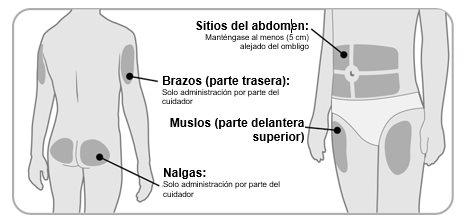
- Нгенла может быть введена в живот (брюшную полость), бедра, ягодицы или верхнюю часть рук.
- Выберите лучшее место для инъекции, как рекомендует ваш врач, медсестра или фармацевт.
- Если необходимо более 1 инъекции для завершения вашей дозы, каждая инъекция должна быть введена в разное место инъекции.
- Невводите в области костей, синяков, покраснений, болезненных или твердых мест или мест с шрамами или кожными заболеваниями.
- Очистите место инъекции ватным шариком, пропитанным спиртом.
- Дайте место инъекции высохнуть.
- Нетрогайте место инъекции после очистки.
Шаг 3 Проверьте лекарственное средство
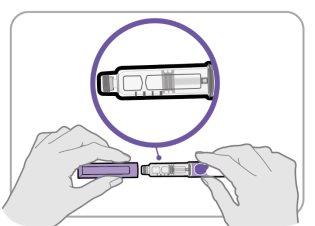
- Снимите колпачок шприца и сохраните его для после инъекции.
- Проверьте лекарственное средство внутри держателя картриджа.
- Убедитесь, что лекарственное средство прозрачно и бесцветно или слегка желтоватое. Невводите лекарственное средство, если оно мутное или имеет темно-желтый цвет.
- Убедитесь, что лекарственное средство свободно от чешуек или частиц. Невводите лекарственное средство, если оно содержит чешуйки или частицы.
Примечание:Нормально видеть одну или несколько пузырьков в лекарственном средстве.
Шаг 4 Поместите иглу
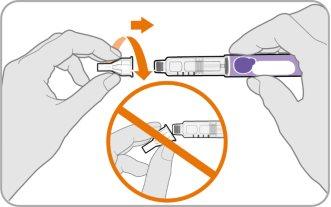
- Возьмите новую иглу и снимите защитную бумагу.
- Выровняйте иглу со шприцем, держа их прямо.
- Аккуратно нажмите и затем завинтите иглу на шприце.
Ненажимайте слишком сильно.
Примечание:Будьте осторожны, чтобы не поставить иглу под углом. Это может сделать так, что шприц будет капать.
Осторожность:Иглы имеют острые концы с обоих сторон. Будьте осторожны, чтобы не уколоть себя (или кого-то другого) иглой.
Шаг 5 Снимите внешний защитный колпачок иглы

- Снимите внешний защитный колпачок иглы.
- Убедитесь, что сохраните внешний защитный колпачок иглы. Вам он понадобится позже для снятия иглы.
Примечание:Вы должны увидеть внутренний колпачок иглы после снятия внешнего защитного колпачка. Если вы не видите этого, попробуйте поставить иглу снова.
Примечание:Если вы используете иглу безопасности, проконсультируйтесь с инструкциями по применению производителя.
Шаг 6 Снимите внутренний колпачок иглы

- Снимите внутренний колпачок иглы осторожно, чтобы показать иглу.
- Утилизируйте внутренний колпачок иглы в контейнер для острых предметов. Он больше не нужен.
Примечание:Если вы используете иглу безопасности, проконсультируйтесь с инструкциями по применению производителя.

(«Да: Перейдите к настройке нового шприца» имеет стрелку, указывающую «Настройка нового шприца (первое использование)», и «Нет» имеет стрелку, указывающую «Настройте свою назначенную дозу»)
Настройка нового шприца (первое использование): только для первого использования нового шприца
Вы должны настроить каждый новый шприц (первое использование) перед его первым использованием
- Настройка нового шприца производится перед первым использованием каждого нового шприца.
- Цель настройки нового шприца - удалить пузырьки воздуха и убедиться, что вы получаете правильную дозу.
Важно:Пропустите шаг А и перейдите к шагу С, если вы уже настроили шприц.
Шаг А: Поставьте кнопку на 0,4

- Поверните дозирующую кнопку на 0,4.
Примечание:Если вы повернете дозирующую кнопку слишком сильно, вы можете вернуться назад.
Шаг Б: Постучите по держателю картриджа
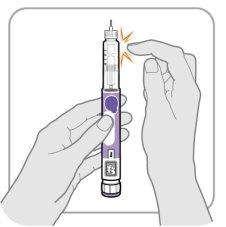
- Держите шприц с иглой, направленной вверх, чтобы пузырьки воздуха могли подняться.
- Постучитепо держателю картриджа, чтобы сделать пузырьки воздуха плавать к верху.
Важно:Следуйте шагу Б, даже если вы не видите пузырьков воздуха.
Шаг В: Нажмите кнопку и проверьте наличие жидкости
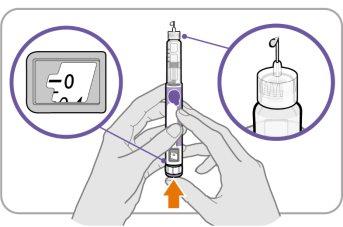
- Нажмите кнопку инъекциидо тех пор, пока она не сможет двигаться дальше, и появится «0»в окне дозы.
- Проверьте, есть ли жидкость на кончике иглы. Если появляется жидкость, ваш шприц настроен.
- Убедитесь, что всегда появляется капля жидкости перед инъекцией. Если жидкость не появляется, повторите шаги с А по В.
- Если жидкость не появляется после повторения шагов с А по В пять раз, поставьте новую иглу и попробуйте еще один раз.
Неиспользуйте шприц, если капля жидкости все еще не появляется. Свяжитесь с вашим врачом, медсестрой или фармацевтом и используйте новый шприц.
Настройте свою назначенную дозу
Шаг 7 Настройте свою дозу
| Пример А
3,8 мг показаны в окне дозы Пример Б
12,0 мг показаны в окне дозы |
- Поверните дозирующую кнопку, чтобы настроить свою дозу.
- Доза может быть увеличена или уменьшена путем поворота дозирующей кнопки в любом направлении.
- Дозирующая кнопка поворачивается на 0,2 мг каждый раз.
- Ваш шприц содержит 24 мг лекарственного средства, но вы можете настроить дозу только до 12 мг за одну инъекцию.
- Окно дозы показывает дозу в мг. См. примерыА и Б.
- Всегда проверяйте окно дозы, чтобы убедиться
- е де haber ajustado la dosis correcta.
Важно:Ненажимайте кнопку инъекции, пока регулируете дозу.
Что мне делать, если я не могу отрегулировать необходимую дозу?
- Если ваша доза превышает 12 мг, вам понадобится более 1 инъекции.
- Вы можете вводить от 0,2 мг до 12 мг за одну инъекцию.
- Если вам нужна помощь в разделении дозы правильным образом, проконсультируйтесь с вашим врачом, медсестрой или фармацевтом.
- Используйте новую иглу для каждой инъекции (см. Шаг4:Установите иглу).
- Если обычно вам необходимо вводить 2 инъекции для полной дозы, убедитесь, что вы вводите вторую дозу.
Что мне делать, если в моей ручке не осталось достаточно лекарства?
- Если ваша ручка содержит менее 12 мг лекарства, кнопка дозирования остановится с оставшимся количеством лекарства, отображаемым в окне дозирования.
- Если в вашей ручке не осталось достаточно лекарства для полной дозы, вы можете:
- Ввести оставшееся количество в вашей ручке, а затем подготовить новую ручку для завершения дозы.
Не забудьте вычесть дозу, которую вы уже получили. Например, если доза составляет 3,8 мг, и вы можете отрегулировать кнопку дозирования только на 1,8 мг, вам необходимо ввести еще 2,0 мг с помощью новой ручки.
- Или получить новую ручку и ввести полную дозу.
Введение дозы
Шаг8 Вставьте иглу
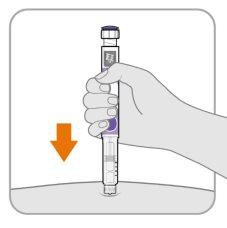
- Держите ручку так, чтобы вы могли видеть цифры в окне дозирования.
- Вставьте иглу прямо в кожу.
Шаг9 Введите лекарство
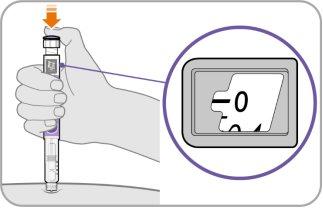
- Продолжайте держать иглу в том же положении на вашей коже.
- Нажмите кнопку инъекциидо тех пор, пока она не сможет двигаться дальше, и не появится «0»в окне дозирования.
Шаг10 Подсчитайте до10
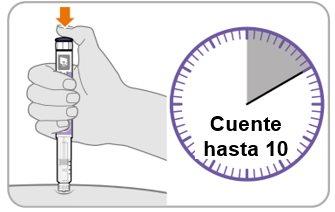
- Продолжайте нажимать кнопку инъекции, пока считаете до10. Отсчет до 10 позволит обеспечить введение полной дозы лекарства.
- После отсчета до 10 отпустите кнопку инъекции и медленно удалите ручку из области инъекции, вытягивая иглу наружу.
Примечание:Возможно, вы увидите каплю лекарства на кончике иглы. Это нормально и не влияет на дозу, которую вы только что получили.
Шаг11 Установите защитный чехол иглы
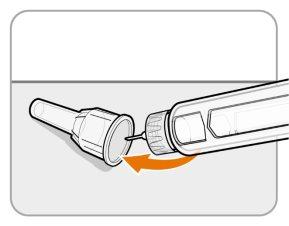
- Осторожно наденьте защитный чехол иглы на иглу.
- Нажмите защитный чехол иглы до тех пор, пока он не будет зафиксирован.
Осторожность:Никогда не пытайтесь снова надеть внутренний колпачок иглы на иглу. Вы можете уколоться иглой.
Примечание:Если вы используете иглу безопасности, проконсультируйтесь с инструкциями производителя.
Шаг12 Удалите иглу
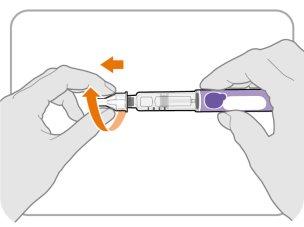
- Отвинтите иглу от ручки.
- Аккуратно потяните до тех пор, пока игла не будет удалена.
Примечание:Если игла все еще установлена, снова наденьте защитный чехол иглы и попробуйте еще раз. Убедитесь, что вы прикладываете давление при отвинчивании иглы.
Утилизируйте использованные иглы ручки в контейнере для острых предметов в соответствии с инструкциями вашего врача, медсестры или фармацевта и местными правилами здоровья и безопасности. Держите контейнер для острых предметов вне досягаемости детей. Неповторно используйте иглы.
Шаг13 Установите колпачок ручки
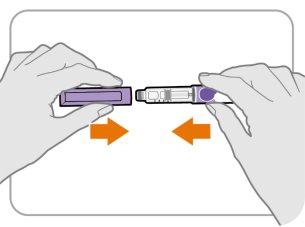
- Установите колпачок ручки на ручку.
- Непокрывайте ручку, если на ней установлена игла.
- Если в вашей ручке осталось некоторое количество лекарства, храните ее в холодильнике между использованиями (см. раздел5 «Хранение Нгенла»проспекта предзагруженной ручки Нгенла 24мг).
Шаг14 После инъекции
- Легко нажмите на область инъекции с помощью ватного шарика или марли и удерживайте его в течение нескольких секунд.
- Нетрите область инъекции. Возможно, у вас будет легкое кровотечение. Это нормально.
- Вы можете покрыть область инъекции небольшим адгезивным пластырем, если необходимо.
- Если ручка пуста или прошло более 28днейпосле первого использования, утилизируйте ее, даже если в ней содержится неиспользованное лекарство. Утилизируйте ручку в контейнере для острых предметов.
- Чтобы помочь вам запомнить, когда утилизировать ручку, вы можете написать дату первого использования на этикетке ручки и затем:
Дата первого использования ______ / ______ / ______
- Страна регистрации
- Активное вещество
- Требуется рецептДа
- Производитель
- Информация носит справочный характер и не является медицинской рекомендацией. Перед приемом любых препаратов проконсультируйтесь с врачом. Oladoctor не несет ответственности за медицинские решения, принятые на основе этого контента.
- Аналоги НГЕНЛА 24 мг Раствор для инъекций в предварительно заполненной шприц-ручкеФорма выпуска: ИНЪЕКЦИОННЫЙ РАСТВОР, 60 мг / 1,2 млАктивное вещество: СоматрогонПроизводитель: Pfizer Europe Ma EeigТребуется рецептФорма выпуска: ИНЪЕКЦИОННЫЙ РАСТВОР, 12 мг соматропинаАктивное вещество: СоматропинПроизводитель: Pfizer S.L.Требуется рецептФорма выпуска: ИНЪЕКЦИОННЫЙ РАСТВОР, 5,3 мг соматропинаАктивное вещество: СоматропинПроизводитель: Pfizer S.L.Требуется рецепт
Аналоги НГЕНЛА 24 мг Раствор для инъекций в предварительно заполненной шприц-ручке в других странах
Лучшие аналоги с тем же действующим веществом и терапевтическим эффектом.
Аналог НГЕНЛА 24 мг Раствор для инъекций в предварительно заполненной шприц-ручке в Украина
Врачи онлайн по НГЕНЛА 24 мг Раствор для инъекций в предварительно заполненной шприц-ручке
Консультация по дозировке, побочным эффектам, взаимодействиям, противопоказаниям и продлению рецепта на НГЕНЛА 24 мг Раствор для инъекций в предварительно заполненной шприц-ручке – по решению врача и с учетом местных правил.




